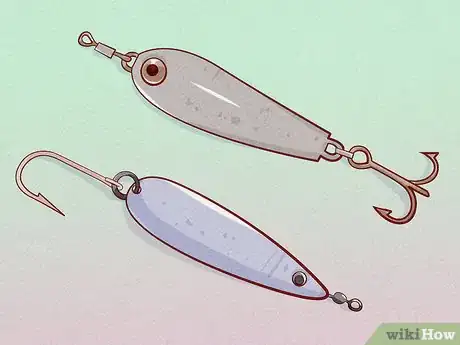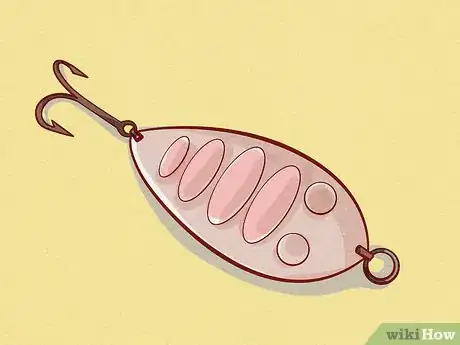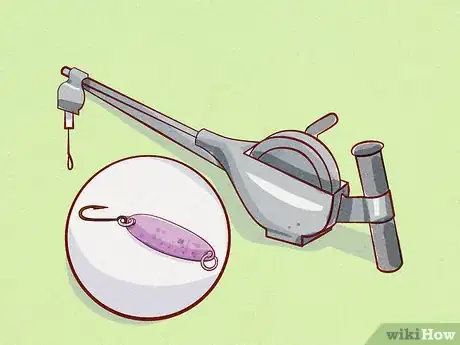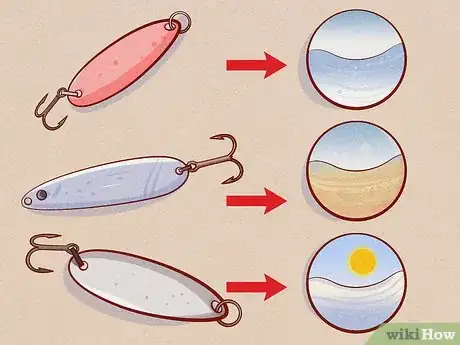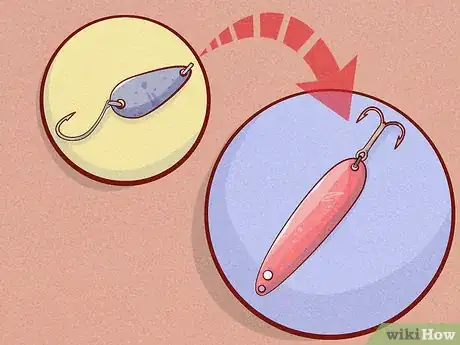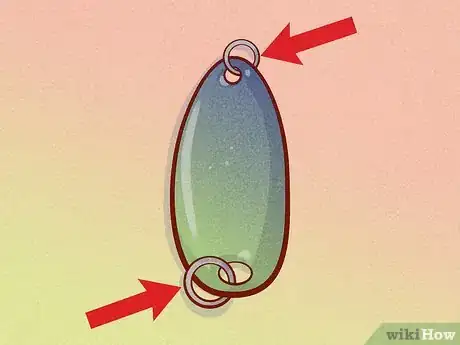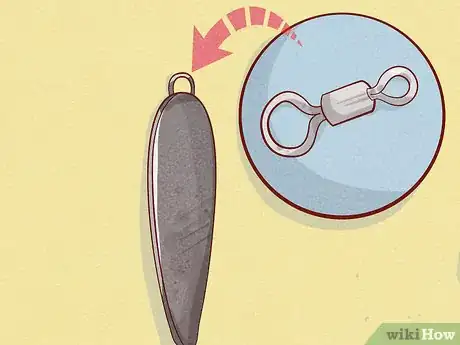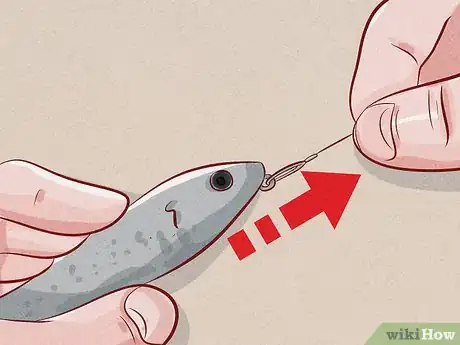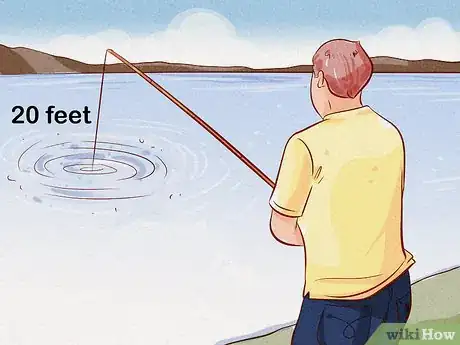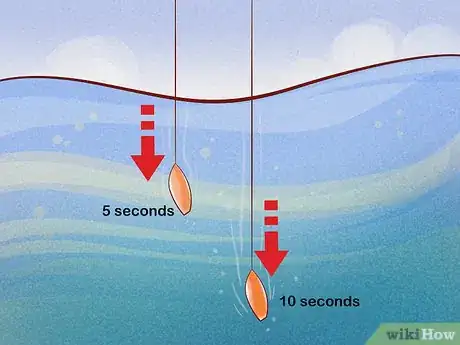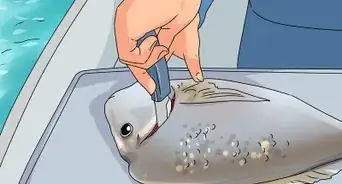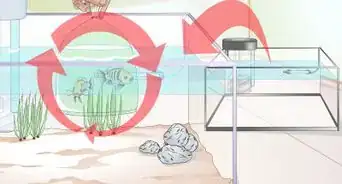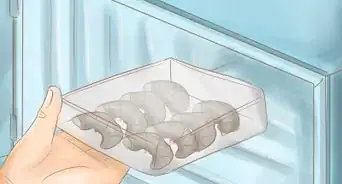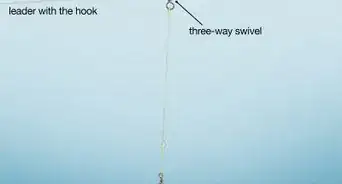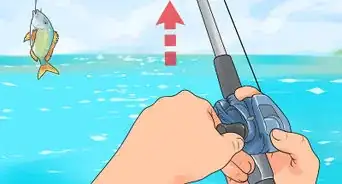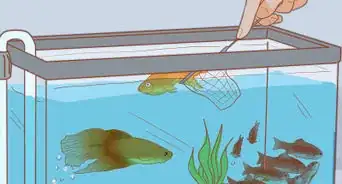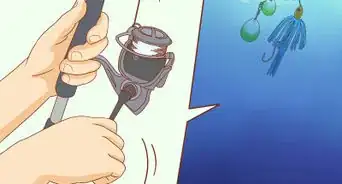This article was co-authored by wikiHow Staff. Our trained team of editors and researchers validate articles for accuracy and comprehensiveness. wikiHow's Content Management Team carefully monitors the work from our editorial staff to ensure that each article is backed by trusted research and meets our high quality standards.
There are 10 references cited in this article, which can be found at the bottom of the page.
This article has been viewed 34,282 times.
Learn more...
Using spoons is a classic method to lure fish, whether it be in deep or shallow waters. The concave piece of plastic, wood, or metal, works by reflecting the sunlight through the water, luring the fish in. Fishing with spoons starts with choosing the right type of spoon. After you've selected the best spoon, it's a breeze to attach it to your rod and head out onto the water.
Steps
Choosing a Suitable Spoon
-
1Choose a spoon that works well with the weather. Knowing what weather the local fish prefer is key to deciding which spoon to use. If the weather is favorable, you'll need a faster spoon, such as a traditional casting spoon, or a surface spoon. If the weather isn't favorable, a trolling spoon, or jigging spoon is best.
- On a calm and sunny day, deep bass will remain active, but their shallow counterparts will hide under trees, foliage, or docks.
- An overcast day encourages predators to hunt near the surface. Expect large pike to patrol the shallows.[1]
-
2Choose a traditional casting spoon for overall versatility. This spoon resembles the classic concave shape used since the 1840's. As the spoon descends in the water, it wiggles from side to side, attracting fish towards it. Traditional casting spoons can be very light or quite heavy depending on the size of fish you're angling.
- This spoon is ideal for pike, lake trout, walleyes, and bass.
Advertisement -
3Try a trolling spoon if you have a downrigger or diving plane. Trolling spoons are much lighter and smaller than their counterparts. A typical 3 in (7.6 cm) trolling spoon will only weigh 1⁄8 ounce (3.5 g). These are used on downriggers or diving planes due to the lightness of the spoon.
- A trolling spoon is ideal for salmon, trout, and walleyes.
-
4Use a weedless spoon in marsh or swampland. Typical spoons often get stuck in weeds and debris. Try a weedless spoon if you're headed out to an area where fish use local foliage for cover. Their streamlined design and wire guard prevent them from getting caught in the water.
-
5Try a jigging spoon for deep water fish. Use a jigging spoon if you know the local wildlife well, or you've picked up a school of fish on your electronics deep underwater. These heavy spoons fall deep in the water. To "jig" the spoon, jerk the line every 5 seconds to make the spoon more attractive.
-
6Select an appropriate color depending on the light. The ideal color of the spoon depends on the light level. Particular colors can enhance the reflection of the sun, making the spoon more effective. Stay prepared by reading the weather forecast before your fishing trip.
- Try a red, yellow, or orange spoon if the water and light are clear and bright.
- If the water is murky, or the light is low, use a blue, indigo, or violet spoon.
- Use a silver spoon on a cloudless day. The reflected sun on the spoon will make attractive bait.[2]
-
7Choose an appropriate size of spoon depending on the time of year. As the fishing season goes on, the fish will grow larger. Select a small spoon at the start of the season for smaller fish. Towards the end of the season, select a larger spoon that'll stick in the fish's mouth, and appear as attractive prey.[3]
-
8Adjust the spoon throughout the fishing day. Light, weather, and fish can vary over a day. Bring a variety of sizes, types, and colors of spoons so that you can change them if you're not having much success. The more research you do before you head out, the more adaptable you'll be on the day.[4]
- Many fishers face the problem of the morning sun. If you head out before dawn on a cloudy day, light levels will be low. However, dawn can present a drastic shift in light and weather conditions. This can make a dark or small spoon appear unattractive. Switch your spoon once the conditions change.
Attaching the Spoon to the Hook
-
1Attach the split rings to both ends of the spoon. All spoons have a hole at the top and the bottom. You'll need to thread a split ring into these holes. Separate the split ring with a pair of pliers and ease it into the hole. Rotate the ring until it snaps onto the spoon. Then, do the same to the other side.[5]
- You can separate a split ring with your hands, but if you don't have long nails, it can be very difficult.
-
2Slot the barrel swivel onto the top end of the spoon. A spoon will have a wide end and a narrow end. The narrow end is the top. Use your pliers to split open the top split ring, then slot the barrel swivel into it. After attaching the rings, you're ready to put the hook on the spoon.[6]
- The barrel swivel allows the spoon to twist and turn. This is useful when the fish attempts to escape. The hook will rotate with the fish, giving you more time to reel it in.
-
3Loop the eye of the hook onto the bottom of the spoon. Rotate the hook so that it's pointing towards the top of the spoon. Then, slot the eye of the hook around the bottom split ring. If the eye too wide you'll need to press it over the hook.[7]
- Place both ends of the pliers over the eye of the hook and the split ring, then push hard. The hook will bend until it forms a secure circle around the split ring.
- Once you've secured the hook, tie the end of the standing line from the rod onto the barrel swivel.
Fishing with the Spoon
-
1Look exactly where you aim to cast. Before you raise the rod, pick a precise spot where you want to cast. Choose a spot around 20 feet (6.1 m) past your target fish. This gives you room to reel the bait in. You'll be much more accurate if you look exactly where you want to cast.[8]
-
2Cast from the side with an explosive snap. Bringing the rod far behind your head and making a large cast is typical of a traditional fishing method. However, a spoon requires a different cast. Gripping the rod, bring your hands to the side of your head before flicking it to the water with your wrists. With some practice, this casting technique is much more accurate.[9]
-
3Let the spoon sink to the appropriate depth. Once you cast the spoon, your natural instinct will be to reel it in. Instead, let the bait drop down into the water. Once you think the spoon has sunk to the depth of the target fish, reel it back in.
- If you're casting in new water and you don't know where the bottom is, try experimenting with the depth. On your first cast, let the spoon sink for 5 seconds. On your second cast, 10 seconds. Keep increasing the time you let the spoon sink until you find the bottom. You'll know you've hit the bottom when the line stops extending.[10]
-
4Experiment with reeling speed. There's a strong chance that you won't catch anything on your first cast. This is normal. Try to experiment with how fast you retrieve the spoon each time. A different speed may attract a different fish. If you're fishing with an experienced friend, they'll be able to give you tips on what speed is best for the local fish.[11]
-
5Flick the rod up and down. The spoon gently fluttering to the bottom of the water imitates a dying fish. To make this performance convincing, try flicking the entire rod up and down once every 5 seconds. This will cause the spoon to flick around in the water.[12]
Things You'll Need
- Spoon
- Pliers
- Hook
- Barrel swivel
- 2 split rings
References
- ↑ http://www.in-fisherman.com/catfish/10-top-fishing-weather-conditions/
- ↑ http://www.lovetheoutdoors.com/freshwater-fishing/Spoons/Spoons.html
- ↑ http://www.lovetheoutdoors.com/freshwater-fishing/Spoons/Spoons.html
- ↑ http://www.lovetheoutdoors.com/freshwater-fishing/Spoons/Spoons.html
- ↑ https://youtu.be/h_o6WMKTbzA?t=77
- ↑ https://youtu.be/h_o6WMKTbzA?t=99
- ↑ https://youtu.be/h_o6WMKTbzA?t=196
- ↑ https://youtu.be/udUTJLkN9MQ?t=57
- ↑ https://youtu.be/udUTJLkN9MQ?t=25
